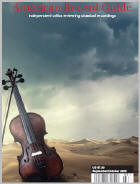Texte paru dans: / Appeared in:
|
|
|
Outil de traduction ~ (Très approximatif) |
|
|
Reviewer: Ralph
Locke Telemann ran the Hamburg opera house in the 1720s 30s, where he kept many Handel operas in the repertory. He wrote 35 or so operas himself for Hamburg and other cities, most of them now lost. Of the 8 surviving ones, the best known is the light-hearted Pimpinone (Mar/Apr 1991; Sept/Oct 1996). Since 1967 the critical edition of Telemann's complete works has published the others, including the one recorded here: Miriways (1728). The world premiere recording of this fascinating work, made at stage performances in 2012, was hailed here by John Barker (Sept/Oct 2014). The present recording, just as fine yet also quite different, preserves a single 2017 unstaged performance in Hamburg's renowned 2000 seat Laeiszhalle (built in 1908). During the Baroque era, most exotic works used librettos telling of events (real or legendary) from the distant past (think of Handel's Giulio Cesare). Miriways, a rare exception, is set in Telemann's own way. I'd call it a "newspaper headlines opera", like such attention getting works from the past few decades as John Adams's Nixon in China and Mason Bates's Revolution of Steve Jobs.
Telemann and his librettist
Johann Samuel Müller built their opera around events that had taken place a
mere six years earlier in what are now Afghanistan and Persia. The main
figure is Miriways, a highly fictionalized version of the Afghani emir known
to history as Mahmud Hotak. The librettist (apparently misled by an
unreliable German language biography of Mahmud) gave him the name of
Mahmud's father, Mirwais Hotak. The confusion is understandable, because
Mirwais (the father) had in 1709 led a revolution of Afghanis against the
Persian forces that controlled Kandahar. In 1722 Afghan troops repeated the
process on grander scale, putting Mahmud (the son) on the throne of Persia
in Isfahan for three years. The German biography of the son (Mahmud) dubbed
him "the Persian Cromwell", creating a parallel with the general whose
forces, in the English Civil War, overthrew a repressive aristocratic
regime. The opera's complex plot did not allude to (relatively) recent
events so concretely, but it did turn the Afghani usurper of the Persian
throne into a benevolent Enlightenment style ruler, who forgives his former
foes and so on. The plot was well summari-zed in John Barker's review. It
involves elements typical of Italian libretti of the day, such as two
couples, where the woman and man are kept apart by complex circumstances
plus an evil schemer (Zemir, a Persian prince) who wants one of the women
for himself. Though the work is labeled a singspiel, it uses secco recitative rather than spoken dialog. The usual string of arias is relieved by one duet, a few short choruses, a march "in Persian style", and several other orchestral movements. There were originally also some dances and a divertissement style "entry" for a group of drunken people, but the music for all of these is lost. The booklet has the libretto in German and English. The translation is full of typos. ("Borw" turns out to be "brow".) Worse, the booklet lacks a synopsis. An essay summarizes the historical and literary background and explains what the costumes and sets may have been like, but barely discusses the music. So I'll tell you: the music is a delight, often resembling, in style, appeal, and high craftmanship, what we find in Handel's operas and oratorios. At first, because the recitatives are in German, I was reminded of Bach's Passion settings. But I eventually got into the spirit and enjoyed the exchanges among the various characters and their quite varied emotions and reactions. Telemann authority Steven Zohn, in an informative review of the published score (in the music library journal Notes), has observed that the scoring is less colorful than in some of Telemann's Hamburg operas (fewer arias with a wind obbligato; only one accompanied recitative). Still, he notes, a chorus of Persians opens with a delightful horn duet, and a sleep aria for Nisibis is accompanied by "muted first violins and oboes d'amore with pizzicato strings". He points to several numbers that "suggest the exotic locale through repetitions of melodic and rhythmic figures, drone basses, and dissonant harmonies"—which Telemann picked up in trips to Eastern Europe and that recur in many of his purely instrumental works, too (sometimes labeled "Polish"). I found the performance, by a renowned Berlin early music orchestra, vivid and enchanting. Labadie makes a point of introducing distinct contrasts of pace in, say, the middle of the A section of an aria. We are far here from the bad old tradition of doing Baroque music metronomically. He adds some percussion (such as wooden sticks quickly hitting each other) in Miriways's first aria. And he takes the above mentioned chorus so quickly that the horn players have to scamper. This is not "playing it safe"; I would instead describe it as "playing a work back to life".
| |
|
|
|
|
Cliquez l'un ou l'autre
bouton pour découvrir bien d'autres critiques de CD |
|




